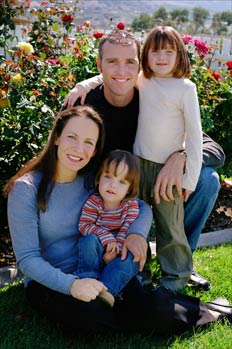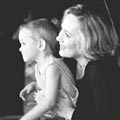Our Story

Rachel, Aaron, Leah, and Lucy
One Mother’s Journey From Adversity to Opportunity
In December of 1996, Rachel Coleman and her husband, Aaron, welcomed their first daughter, Leah, into the world. At the time, Rachel was writing music and performing with her folk rock band. They would take young Leah to band practices and concerts and were amazed that she was able to sleep in spite of the loud music. When she was fourteen months old, they discovered why: Leah was profoundly deaf.
To say the least, their world turned upside down. Rachel’s priorities instantly changed. She put down her guitar and picked up sign language. She and her husband immediately started teaching American Sign Language (ASL) to Leah as fast as they could learn it. Something remarkable happened: by the time Leah was 18 months old, her baby sign language vocabulary far surpassed the spoken vocabulary of “hearing” children her same age. While Leah’s little friends could only point and whine for something they wanted, Leah could sign, “Juice, not milk” or, “Cheese and crackers, please”. Other parents took notice, including Rachel’s sister, Emilie, who started teaching sign language to her infant son, Alex, so that he would be able to communicate with Leah. Emilie was thrilled one morning when baby Alex, then only ten months old, found his own use for sign language. He stopped fussing, looked up at her, and signed “milk”.

Leah Coleman
A few years later, Rachel and Aaron’s second daughter, Lucy, was born. After dealing with Leah’s deafness, they felt a second child would be easy. However, Lucy arrived eight weeks premature with spina bifida and cerebral palsy. Doctors worried that Lucy would never be able to speak, let alone use her rigid fingers to sign with her deaf sister.

Emilie and Alex
Somewhere in the midst of all of this, Rachel and her sister Emilie decided to team up to create a captivating, entertaining video to teach sign language to children who were not deaf. Their plan was to make a short video that gave their friends and family a fun and easy way to learn ASL as a second language, but most importantly to give them enough basic signs to communicate with Leah. In May of 2002 the first volume of Signing Time was completed, starring Rachel, 3-year-old Alex and 4-year-old Leah. The response was overwhelming. Word spread from mom to mom and family to family. Before long, the small community of people learning to sign with Leah grew into an expansive community of parents, educators, and health professionals using Signing Time to introduce the benefits of sign language to children everywhere. Testimonials poured in with touching stories about how Signing Time had been instrumental in dissolving communication barriers and giving a “voice” to children who previously had no way to express themselves. Everyone wanted more Signing Time. Rachel and Emilie’s company, Two Little Hands Productions, was born.
Lucy Coleman
Shortly after the release of Volume 1, the Coleman family experienced a miracle of their own making. After two years of no communication, Rachel’s second daughter, Lucy, then two years old, was not communicating at all. No signs…nothing. One day while watching Signing Time, Lucy attempted a gesture that Rachel had never seen before, but looked like the sign for “more”. Rachel said, “Lucy, do you want more?” Lucy’s eyes opened wide as if to convey, “Hey mom, you got it right!” From that point forward, Lucy’s sign language vocabulary slowly but steadily increased, despite her physical challenges and gloomy prognosis. Shortly thereafter, Lucy started talking. By the time she reached the age of five, Lucy began attending mainstream kindergarten, something Rachel never imagined possible. Lucy continues in a mainstream classroom to this day and excels in her schoolwork.
It’s Time for Signing Time
Around the time Signing Time was being developed, the media began to pick up on the benefits of signing with hearing infants. While most people at the time still thought sign language was only for the deaf, scores of parents everywhere began to pay attention and joined Rachel, Emilie and other proponents of “baby sign language”, sharing it as a powerful means of teaching babies and toddlers to communicate before they can talk.
Scientific studies show that “typical” children who learn to sign as babies:
- have higher IQ scores than those who do not sign
- tend to be better adjusted socially
- tend to read at an earlier age
Many parents observe that by learning to communicate earlier, the “terrible twos” are not so terrible – children can use a sign instead of throwing a tantrum to express their needs.
In the 2004 sequel to “Meet the Parents” Robert DeNiro’s character was teaching his baby grandson “Little Jack” to sign so that he would be smarter.
Emilie signs ‘socks’ during
production of Volume 2
(Little Jack was played by twins Spencer and Bradley Pickren, who actually did learn sign language from Signing Time.) While the movie was comedic in nature, it marked the point of mainstream awareness of signing as a revolutionary parenting tool.
For All Children Everywhere
Evidence is also mounting that children with special needs, such as apraxia of speech, autism, or down syndrome who have difficulty with speech can make great strides in their communication development when Signing Time is part of their regimen. The multi-sensory approach of Signing Time engages visual learners, kinesthetic learners, and auditory learners of all ages and abilities, while making sign language easy and fun.
Thanks in large part to Signing Time, sign language is now gaining recognition as an all-encompassing tool for communication that anyone can use. Signing Time is used widely by educators, pediatricians, home-schoolers, speech therapists, public schools, daycare centers, libraries, and families. Whether used by a pre-verbal infant, a non-verbal child with disabilities, or a family who simply wants to learn ASL as a second language, signing has become an important part of American culture.
While sign language is beneficial for every child, Rachel confesses a more personal goal. She says, “My hope is that everyone will know a little sign, just as most people know a little Spanish – so when your child sees my child at the park, there would be no awkwardness, no communication barrier, just three signs… “Hi … friend … play’… that is all it would take to change her world.”
Epilogue
Today, Two Little Hands Productions offers a full line of children’s products that uses music and sign language to promote early learning. All of the videos, music and more are available digitally on MySigningTime.com. Digital videos can be purchased, or are available as a monthly or yearly Subscription. Their brands include Signing Time, Baby Signing Time, Potty Time, and Rachel & the TreeSchoolers. Rachel & Me is the newest series available exclusively on MySigningTime.com.
Two Little Hands is truly a family business: Rachel and Emilie’s father, Lex de Azevedo, was the CEO for many years. Christian, their younger brother, is now COO and youngest brother, Aaron, is in production and marketing. Rachel’s husband, Aaron, is involved in filming.
Emilie and her husband, Derek, welcomed three more children into their family: Zac, Eliza, and Spencer. Rachel’s family grew, too. She was reunited with her daughter, Laura, whom she had placed for adoption before Leah and Lucy were born.
